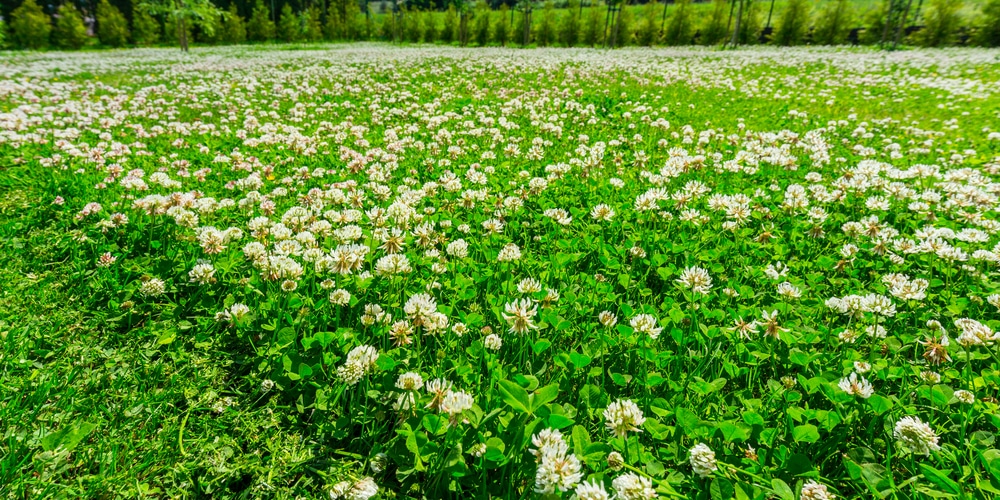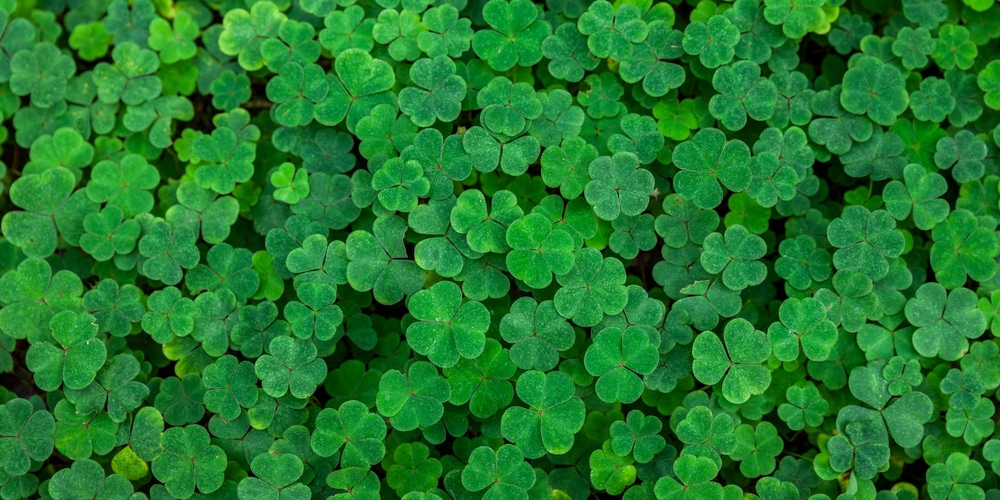Clover as a Lawn Companion Plant
Clover is a powerhouse when used alongside grass seeds to create a healthier, more sustainable lawn.
Explore its numerous benefits and the various types that work best in tandem with traditional turfgrasses.
Benefits of Clover in Lawn Care
- Nitrogen Fixation: Clover has the remarkable ability to convert atmospheric nitrogen into a form that plants can use. This natural fertilization process reduces your need for synthetic fertilizers.
- Drought Resistance: With its deep roots, clover is able to access water from deeper within the soil, providing resilience during dry spells and reducing your lawn’s water demand.
- Weed Suppression: The dense growth habit of clover outcompetes many common weeds, helping to maintain a neat and less labor-intensive lawn.
- Attracts Beneficial Insects: Your clover-filled lawn will become a haven for helpful insects, including bees which are vital for pollination.
Types of Clover for Lawn Mixtures
- White Clover: Famous for its durability and low-growing nature, white clover is a popular choice for mixed lawns due to its preference for mowing heights similar to grass.
- Microclover: A more diminutive relative of white clover, microclover blends seamlessly with grass and maintains a consistent green color even in low-nutrient conditions.
Preparing the Lawn for Seeding with Clover
Before introducing clover to your lawn, it’s essential to ensure that the soil is adequately prepared and that you’ve selected the right type of grass seed to coexist with your new clover.
The success of your lawn project hinges on these initial steps.
Soil Assessment and Amendment
- Test the Soil: Begin by checking the pH level of your soil.
Ideally, clover prefers a pH between 6.0 and 7.0. Use a soil test kit to determine the pH and nutrient levels.
- Amend Accordingly: If your soil test reveals deficiencies, amend your soil to meet the needs of both the clover and the grass seed.
Lime can raise pH, while sulfur can lower it. Fertilize if necessary to add missing nutrients, targeting those recommended by the soil test.
Selecting the Right Grass Seed
- Choose a Compatible Mix: Select a grass seed that thrives in conditions similar to clover.
Grass varieties that perform well in mixed lawns include fine fescue, tall fescue, and perennial ryegrass.
- Consider Shade and Traffic: Evaluate the amount of sunlight and foot traffic your lawn receives.
Choose seed types that are tolerant to your specific conditions to ensure both the grass and clover flourish together.
Seeding Techniques for Clover Integration
Proper seeding techniques are crucial when integrating clover into your lawn.
To achieve a lush, green lawn, it’s important to use the correct seed mixing ratios and application methods for clover.
Seed Mixing Ratios
- White Clover: Typically, for a new lawn, you’d mix approximately 2 ounces of clover seed for every 1,000 square feet with your chosen grass seed.
- For overseeding an existing lawn to introduce clover, roughly 1 ounce per 1,000 square feet suffices.
- Red Clover: Being larger, red clover seeds require a slightly different ratio.
- When mixed with grass seed, use about 4 ounces per 1,000 square feet for new lawns and 2 ounces when overseeding.
Remember, these ratios are guidelines to ensure both grass and clover have room to establish without outcompeting each other.
Application Methods
- Even Distribution: It’s essential to spread the seed mixture evenly across the soil.
- This can be done by hand for small areas or with a seed spreader for larger lawns.
- Ensure consistent coverage to avoid patchy areas.
- Proper Soil Contact: After spreading, lightly rake the area to help seeds make good contact with the soil, which is critical for germination.
- Depth should not exceed 1/4 inch.
- Post-Seeding Care: Water the newly seeded area gently but consistently, keeping the soil moist to facilitate growth.
- Avoid heavy watering that could displace the small seeds.
Maintenance of a Clover-Grass Lawn
Maintaining a clover-grass lawn involves specific watering practices and mowing strategies to ensure optimal growth and vitality.
Watering and Fertilization
- Water Requirements: Your clover-grass lawn generally needs less water than pure grass lawns.
- Aim to provide about 1 inch of water per week, whether through rainfall or supplemental watering.
- Fertilization: Clover fixes nitrogen naturally, reducing the need for chemical fertilizers.
- If needed, use organic options to gently boost nutrient levels, focusing on phosphorus and potassium, as nitrogen is less of a concern.
Mowing Strategies
- Height Preference: Mow your lawn to about 2.5 to 3 inches to promote clover growth and support grass health.
- Clippings: Leave the grass clippings on the lawn after mowing. They decompose and provide additional nutrients, acting as a natural fertilizer.
- Frequency: Regular mowing is beneficial but do not overdo it. Mowing every 3-4 weeks is usually sufficient for a clover-grass mix.
Common Challenges and Solutions
When incorporating clover into your lawn, you’ll encounter a few obstacles, but fear not—effective strategies are readily available.
Controlling weeds and managing pests and diseases are vital to maintaining a vibrant clover lawn.
Weed Management in Clover Lawns
Your clover lawn can be an oasis of green, but unwelcome weeds can crash the party. To keep these invaders at bay:
- Identify the weed types: Recognizing whether you’re dealing with broadleaf or grassy weeds shapes your approach.
- Physical removal: For small areas, hand-pulling weeds is effective, especially when the soil is moist.
- Mowing strategy: Maintain a higher mowing height to give clover the upper hand against common weeds.
- Selective herbicides: If necessary, opt for a clover-safe herbicide to target persistent weeds.
Incorporating clover can reduce the need for aeration due to its root structure that fosters soil health, helping minimize weed invasions.
Pest and Disease Control
Clover is hardy but not immune to pests and diseases. Here’s how to keep your lawn healthy:
- Regularly inspect your lawn for signs of pest activity or disease.
- Encourage beneficial insects, such as ladybugs and lacewings, that prey on aphids and other common clover pests.
- Avoid overwatering, which can lead to fungal diseases like root rot.
- If pests persist, consider organic pest control options that are specifically labeled safe for clover.
Frequently Asked Questions
In this section, we cover essential questions about using clover as a companion to grass in lawns, providing clear guidance for establishment, maintenance, and considerations unique to clover.
What are the benefits of incorporating clover into a traditional grass lawn?
- Improved Soil Health: Clover enriches the soil by fixing nitrogen, reducing the need for chemical fertilizers.
- Drought Tolerance: Your lawn may remain lush due to clover’s drought-resistant nature, lessening the need for frequent watering.
For a detailed discussion of the benefits, see the outlined points at The Spruce.
How do I establish a clover lawn from scratch?
- Mow your existing grass to about 2 inches to allow seeds to reach the soil efficiently.
- Rake the area to remove debris and create a suitable seedbed.
For seeding rates and more specific steps, refer to the guidelines provided by The Spruce.
What considerations should I take into account when maintaining a clover lawn during winter?
- Minimal Upkeep: Clover requires little to no mowing during colder months.
- Cold Tolerance: Most clover species can survive winter without extensive care.
For guidance on winterizing your clover lawn, you might want to read tips from Bob Vila.
Can clover coexist with grass without overtaking it?
- Clover can balance in harmony with your grass if monitored and maintenance practices are adjusted accordingly.
Investigate the balance between clover and grass at Forbes Home.
Are there any drawbacks to having a lawn comprised primarily of clover?
- Staining: Clover flowers may stain clothing more easily than grass.
- Bee Attraction: The blooms attract bees, which can be a concern if you’re allergic or have small children who play on the lawn.
Reflect on these factors by visiting Natural Fertilizer, Attracts Pollinators.
What is the best method for sowing clover seed in an existing lawn?
- Clear away any leaves or debris from your lawn.
- Lightly sprinkle clover seeds or use a hand-powered seed spreader for even distribution.
Learn precise sowing techniques from the experts at Better Homes & Gardens.
Last update on 2025-06-06 / Affiliate links / Images from Amazon Product Advertising API








